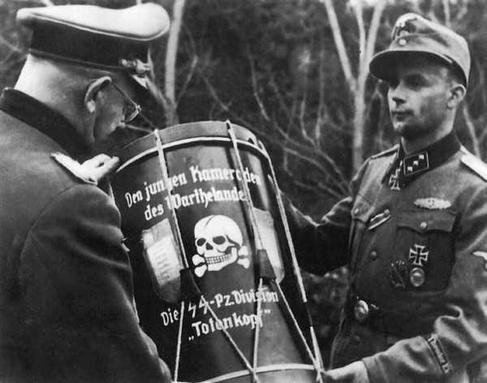awards
|
promotions
|

Kurt Franke was born on the 13 May 1915, in Wurzen, Saxony. In 1935 he volunteered to join the SS and in 1938 served in the concentration camp service of the SS until 1940 when he was transferred to the new SS-Division "Totenkopf" as a platoon commander.
During the Battle of France, Franke was awarded the Wound Badge and the Iron Cross 2nd class.
In 1941, Franke participated in the invasion of the Soviet Union (Operation Barbarossa), Franke now an Unterscharführer, was awarded the Eastern Front Medal for service on the Eastern Front during the 1941 to 1942 winter and the Demyansk Shield awarded to all troops involved in the battles for the Demyansk Pocket, thereafter he, along with the rest of the Division was withdrawn to France to recover.
Kurt Franke returned to the Eastern Front, for the Battle of Kharkov, where he was awarded the Iron Cross 1st class. He was noticed by his superiors as a man to turn to in difficult situations and time after time was given missions to lead against the Soviet positions. He was also awarded the Close Combat Clasp in Bronze.
In August 1943 he was involved in the fighting on the Mius-Front where he was awarded the Close Combat Clasp in Silver, followed in October 1943 by the award of the Knight's Cross.
In January 1944, Franke was given the position of the Battalion Ordinance officer. In this capacity, Franke on 21 March, gathered a command of store men, radio operators and drivers to cover a gap in the German front at Olgopol]. A short time later he returned to command the 11. Kompanie at Kotowsk and was promoted to SS-Untersturmführer in April 1944. For his achievements as the Ordinance officer he was awarded the German Cross in Gold.
In December 1944, the Totenkopf was sent to Hungary, together with the SS Wiking Division. Franke and his company was selected to lead the Battalion in the coming fighting and on the 19 January 1945, he was mortally wounded and died in the Hospital.
Two months later when the reports of the fighting had been submitted Franke was given a posthumous award of the Close Combat Clasp in Gold.
During the Battle of France, Franke was awarded the Wound Badge and the Iron Cross 2nd class.
In 1941, Franke participated in the invasion of the Soviet Union (Operation Barbarossa), Franke now an Unterscharführer, was awarded the Eastern Front Medal for service on the Eastern Front during the 1941 to 1942 winter and the Demyansk Shield awarded to all troops involved in the battles for the Demyansk Pocket, thereafter he, along with the rest of the Division was withdrawn to France to recover.
Kurt Franke returned to the Eastern Front, for the Battle of Kharkov, where he was awarded the Iron Cross 1st class. He was noticed by his superiors as a man to turn to in difficult situations and time after time was given missions to lead against the Soviet positions. He was also awarded the Close Combat Clasp in Bronze.
In August 1943 he was involved in the fighting on the Mius-Front where he was awarded the Close Combat Clasp in Silver, followed in October 1943 by the award of the Knight's Cross.
In January 1944, Franke was given the position of the Battalion Ordinance officer. In this capacity, Franke on 21 March, gathered a command of store men, radio operators and drivers to cover a gap in the German front at Olgopol]. A short time later he returned to command the 11. Kompanie at Kotowsk and was promoted to SS-Untersturmführer in April 1944. For his achievements as the Ordinance officer he was awarded the German Cross in Gold.
In December 1944, the Totenkopf was sent to Hungary, together with the SS Wiking Division. Franke and his company was selected to lead the Battalion in the coming fighting and on the 19 January 1945, he was mortally wounded and died in the Hospital.
Two months later when the reports of the fighting had been submitted Franke was given a posthumous award of the Close Combat Clasp in Gold.
DISCLAIMER: 2. Kompanie is a non-political organization We do not support naziism, or fascism. We are not associated with nor do we condone the actions of the Third Reich or the actual 3.SS Division.
